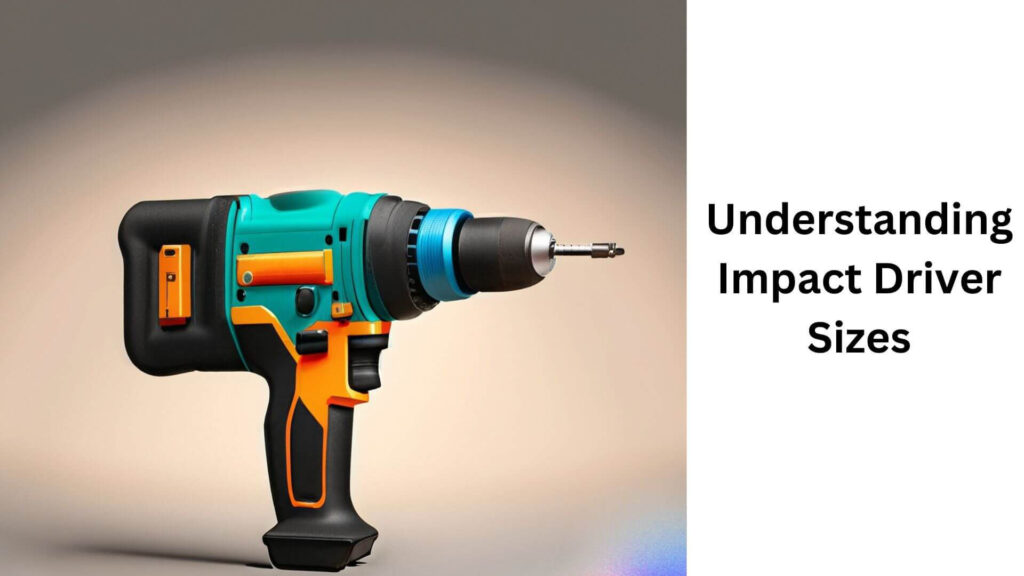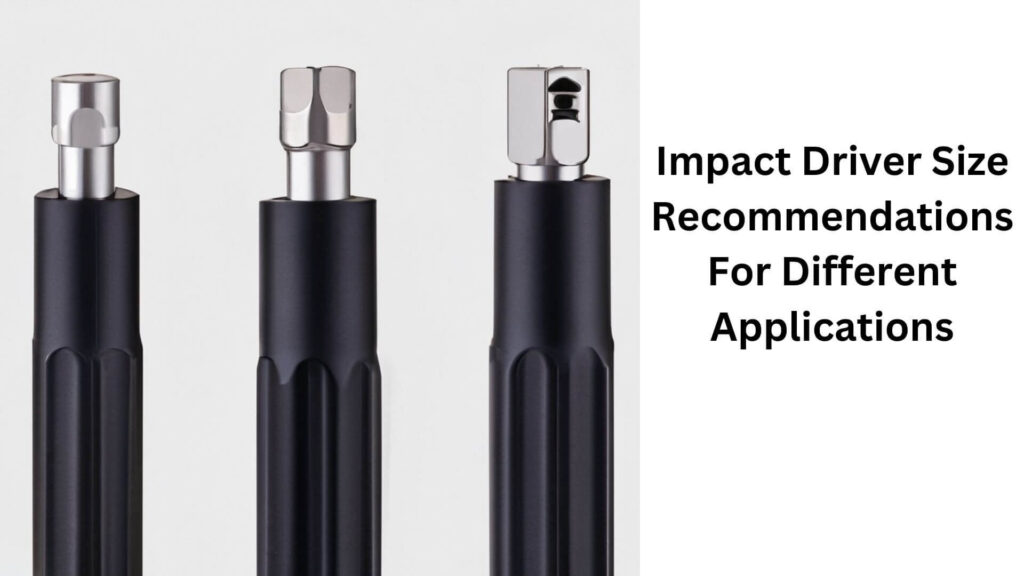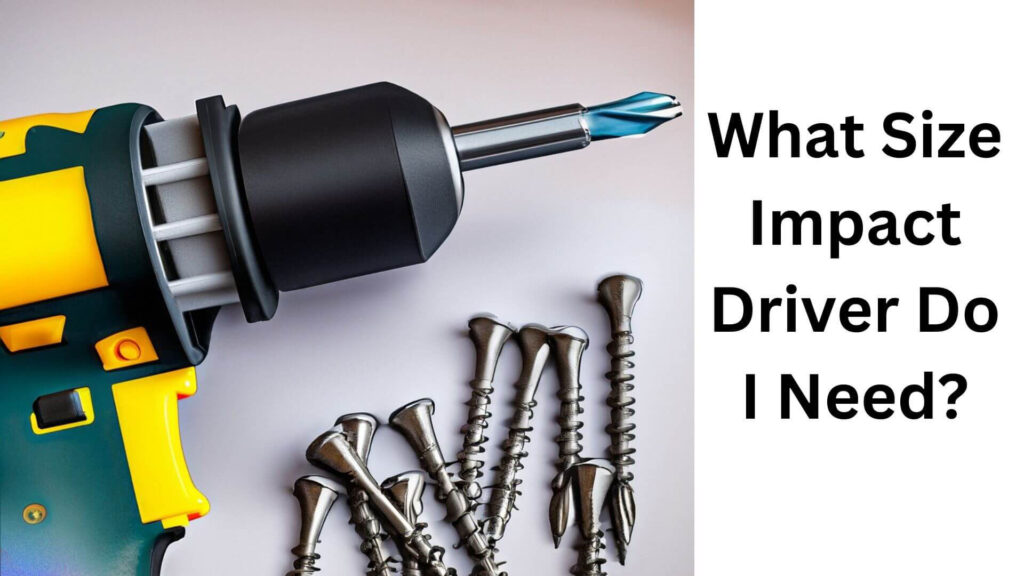Choosing the right size impact driver can make a significant difference in the success of your project, as well as your overall experience using the tool. Impact drivers come in a variety of sizes, each suited to different tasks. Whether you’re driving screws, bolts, or even drilling into tough materials, the size of your impact driver can affect its performance, comfort, and functionality.
In this blog post, I’ll guide you through understanding impact driver sizes, the pros and cons of each, how to measure them, and the best recommendations for various applications. By the end, you’ll have a clearer understanding of what size impact driver will best meet your needs.
Table of Contents
Understanding Impact Driver Sizes

Impact drivers are powerful tools designed to deliver high torque with minimal effort. Unlike drills, they use hammering action to drive screws and bolts into tougher materials. One of the most important aspects of choosing an impact driver is selecting the right size, which is generally determined by the voltage and the chuck size.
- Voltage: This refers to the power output of the impact driver and is a key factor in its capability. Higher voltage typically means more power and torque.
- Chuck Size: The chuck is where the bit is inserted. Most impact drivers have a ¼-inch hex chuck, which is the standard size for impact drivers, making them compatible with most hex-shank bits.
Let’s dive into the different sizes of impact drivers available and their uses.
Different Impact Driver Sizes Available
Impact drivers come in different voltage ratings, which affect their power and application. The most common sizes are:
1. 12V Impact Driver
A 12V impact driver is considered lightweight and compact, making it ideal for light-duty tasks. This size is perfect for DIYers or people who perform minor household jobs like furniture assembly, installing shelves, or driving screws into softer materials like wood.
- Use Cases: Light woodworking, basic household tasks, assembling furniture, or working in tight spaces.
- Pros: Portable, lightweight, and easy to handle.
- Cons: Limited power, not suitable for heavy-duty tasks or large screws.
2. 18V or 20V Impact Driver
The 18V and 20V impact drivers are the most popular sizes for both professionals and serious DIYers. These drivers deliver significantly more power than the 12V models and can handle medium to heavy-duty tasks.
- Use Cases: Driving larger screws, working with tougher materials like hardwood, metal, and masonry.
- Pros: High torque and versatility, suitable for most medium-to-heavy applications.
- Cons: Heavier and larger than 12V models, may cause hand fatigue over prolonged use.
3. 36V and Above
For extremely demanding tasks, such as working with thick metal or large construction bolts, impact drivers with 36V or higher are available. These are industrial-grade tools that provide maximum torque and are typically used by professionals.
- Use Cases: Construction sites, large industrial jobs, drilling into dense materials like concrete and metal.
- Pros: Maximum power and torque, excellent for heavy-duty applications.
- Cons: Expensive, bulky, and heavier, making them impractical for casual use.
Pros And Cons Of Each Size
To help you decide which size is best for your needs, let’s break down the pros and cons of each impact driver size.
12V Impact Driver
- Pros:
- Lightweight and easy to maneuver.
- Ideal for smaller projects.
- Less expensive than higher-voltage models.
- Cons:
- Limited power.
- Not suitable for drilling or driving large fasteners.
18V or 20V Impact Driver
- Pros:
- Versatile and powerful for most jobs.
- Perfect balance between size and power.
- Widely available with many accessory options.
- Cons:
- Heavier and bulkier than 12V models.
- More expensive than entry-level drivers.
36V and Higher Impact Driver
- Pros:
- Extremely powerful and capable of handling the toughest jobs.
- Best for heavy-duty applications.
- Cons:
- Very heavy and less portable.
- Overkill for most household tasks.
- High cost.
How To Measure Impact Driver Sizes
Impact driver sizes are primarily measured by their voltage, but the chuck size and the overall tool size also play a role.
Overall Size and Weight: When selecting an impact driver, consider the tool’s overall size and weight. A more compact tool will be easier to use in tight spaces and for extended periods, while larger tools may provide more power but can cause fatigue.
Voltage Measurement: Impact drivers are often marketed by their voltage. A higher voltage means the tool can deliver more torque, which is crucial for tougher tasks. Common options include 12V, 18V, 20V, and 36V.
Chuck Size: Most impact drivers use a ¼-inch hex chuck, which means they accept bits with a hexagonal shank. This is the most common size for impact drivers, though some larger drivers may accept different bit sizes.
Quick Guide: Installing Drill Bits into Impact Drivers
Factors To Consider When Choosing Impact Driver Sizes
When selecting the right size impact driver, there are several factors to consider based on your specific needs and projects:
1. The Task at Hand
- For light-duty tasks (like assembling furniture or installing shelves), a 12V driver should be sufficient.
- For medium-duty tasks (such as driving screws into hardwood or handling moderate construction work), a 18V or 20V driver is ideal.
- For heavy-duty tasks (like drilling into concrete or metal, or working on construction projects), you’ll need a 36V driver.
2. Frequency of Use
- If you use your impact driver occasionally for home projects, a 12V or 18V impact driver might be all you need.
- For regular, professional use, investing in a 20V model may provide the right balance of power, durability, and versatility.
3. Material Type
The type of material you’re working with also plays a critical role in determining the right size impact driver. Harder materials like metal, concrete, and masonry require more power, meaning you should opt for a 18V or higher impact driver.
Read More: 7 Best Impact Driver For Electricians
Impact Driver Size Recommendations For Different Applications

Let’s break down some common tasks and the recommended impact driver size for each:
Light-Duty Projects
For simple tasks like assembling flat-pack furniture, driving small screws, or hanging pictures:
- Recommended Size: 12V impact driver.
Medium-Duty Projects
For tasks like driving longer screws, drilling into hardwood, or light construction:
- Recommended Size: 18V or 20V impact driver.
Heavy-Duty Projects
For drilling into masonry, driving large bolts, or working with dense materials like concrete or steel:
Recommended Size: 36V impact driver.
Impact Driver Accessories
To maximize the versatility of your impact driver, you’ll need the right accessories:
1. Impact-Rated Bits
Since impact drivers produce more torque than standard drills, you’ll need impact-rated bits that can withstand the force without breaking.
2. Socket Adapters
Socket adapters allow you to use your impact driver for tightening or loosening nuts and bolts. These adapters convert your ¼-inch hex chuck into a socket driver for even more versatility.
3. Extension Attachments
An extension attachment can help you reach tight or awkward spaces when driving screws or bolts.
4. Bit Holders
Magnetic bit holders can make switching between bits quicker and more convenient, especially when you need to change between different screw or drill sizes.
Read More: How Does an Impact Driver Work?
Frequently Asked Questions Of What Size Impact Driver Do I Need
1. Can I Use a 12V Impact Driver for All Tasks?
While a 12V impact driver is great for light-duty tasks, it may not provide enough power for more demanding jobs like drilling into masonry or driving large fasteners. For tougher tasks, you’ll need an 18V or 20V impact driver.
2. What Size Impact Driver Is Best for Professional Use?
For most professional applications, a 18V or 20V impact driver strikes the perfect balance between power, versatility, and maneuverability. It’s powerful enough for most tasks without being overly bulky.
3. Can I Use an Impact Driver for Drilling?
Yes, you can use an impact driver for drilling if you use impact-rated drill bits. However, a standard drill may be better suited for precision drilling tasks.
4. Are 18V and 20V Impact Drivers the Same?
The difference between 18V and 20V impact drivers is primarily a marketing distinction. The actual power output is nearly identical, and both can handle the same tasks.
Final Word
Choosing the right size impact driver is crucial to ensuring the success and efficiency of your project. The 12V, 18V, and 36V impact drivers each offer distinct advantages depending on your task requirements, from light DIY projects to heavy-duty professional applications.
By understanding the specific tasks you’ll be working on, the materials involved, and how often you’ll use the tool, you can confidently choose the right size impact driver that suits your needs. Pairing your impact driver with the appropriate accessories will further enhance its functionality, ensuring that you get the most out of your tool.

Hey, I am MD Hrithik Hossain, I’m a huge fan of DIY crafts. My workshop is where I spend most of my spare time, and I’m always working on some project. To that end, I’d like to share some of my knowledge and experience with you in power tools, woodworking, and other specialized materials fabrication.
I will guide you with genuine knowledge that can assist you with deciding whether a drill is appropriate according to your requirements or not. If you want to find the best drill and know which type of drill is most suited for your needs, then I can guide you with my expertise. My passion lies in helping others find the correct products they need at an affordable price.


